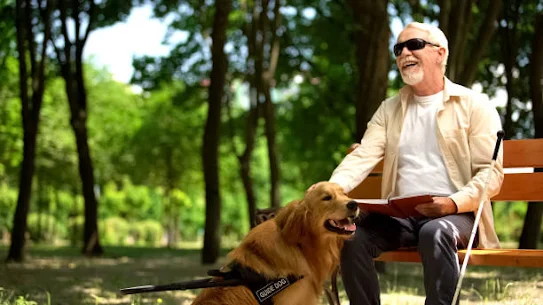Guide dogs: promoting independence and mobility
In
a world where independence and mobility are essential, guide dogs play a
crucial role in assisting individuals with visual impairments. These
highly trained and intelligent animals provide a sense of freedom,
companionship, and safety to their handlers. This comprehensive guide
will delve into the world of guide dogs, exploring their training
process, benefits, and the impact they have on the lives of visually
impaired individuals.
Section 1: Understanding Guide Dogs
What are Guide Dogs?
Guide
dogs, also known as service dogs, are specially trained canines that
assist individuals with visual impairments in navigating their
surroundings. These dogs undergo rigorous training to learn various
commands and techniques that enable them to guide their handlers safely.
Breeds of Guide Dogs
Guide
dogs can come from various breeds, including Labrador Retrievers,
Golden Retrievers, and German Shepherds. These breeds are chosen for
their intelligence, temperament, and physical attributes that make them
suitable for guide work.
The Training Process
The training process for guide dogs is extensive and requires specialized trainers. It typically begins when the dogs are puppies and continues for several months. The training includes obedience, socialization, and specific skills such as obstacle avoidance, street crossing, and locating objects.
Qualities of a Guide Dog
Guide dogs possess a unique set of qualities that make them effective in their role. They are intelligent, adaptable, and have excellent problem-solving skills. These dogs must also be calm, patient, and able to handle various environments and situations.
Section 2: The Benefits of Guide Dogs
Enhancing Independence
One of the primary benefits of guide dogs is the increased independence they provide to individuals with visual impairments. These dogs enable their handlers to navigate their surroundings with confidence, allowing them to travel independently and participate in various activities.
Improving Mobility
Guide dogs significantly enhance mobility for visually impaired individuals. They are trained to guide their handlers around obstacles, navigate busy streets, and locate specific destinations. This mobility assistance empowers individuals to move freely and safely in their daily lives.
Emotional Support
Beyond their practical assistance, guide dogs also offer emotional support to their handlers. The bond between a guide dog and its handler is strong, providing companionship, comfort, and a sense of security. This emotional connection can greatly improve the overall well-being and quality of life for visually impaired individuals.
Increased Confidence
Guide dogs instill a sense of confidence in their handlers. With their assistance, individuals with visual impairments can overcome challenges and face the world with greater self-assurance. The presence of a guide dog can help alleviate anxiety and provide reassurance in unfamiliar or challenging situations.
Section 3: The Impact of Guide Dogs
Social Integration
Guide dogs play a vital role in facilitating social integration for visually impaired individuals. These dogs serve as a conversation starter, breaking down barriers and initiating interactions with others. They help their handlers feel more included and connected to their communities.
Employment Opportunities
Guide dogs open up employment opportunities for individuals with visual impairments. With the assistance of a guide dog, individuals can navigate their workplaces more effectively, increasing their independence and productivity. This opens doors to a wider range of career options.
Educational Support
Guide dogs also provide support in educational settings. They assist visually impaired students in navigating school campuses, locating classrooms, and participating in various activities. This support ensures that visually impaired students have equal access to education and the opportunity to thrive academically.
Travel Assistance
Guide dogs are invaluable when it comes to travel. They help their handlers navigate airports, train stations, and other transportation hubs, making travel more accessible and less stressful. With their assistance, visually impaired individuals can explore new places and experience the joys of travel.
FAQ
Q1: How are guide dogs trained?
Guide dogs undergo extensive training from a young age. They are taught obedience, socialization, and specific skills such as obstacle avoidance and street crossing. The training process involves professional trainers who use positive reinforcement techniques to shape the dogs' behavior.
Q2: Can anyone get a guide dog?
Guide dogs are specifically trained to assist individuals with visual impairments. To qualify for a guide dog, individuals must meet certain criteria and go through an application process. This ensures that guide dogs are matched with individuals who can benefit from their assistance.
Q3: How long does it take to train a guide dog?
The training process for guide dogs typically takes several months. However, the duration can vary depending on the individual dog's progress and the specific training program. It requires patience, consistency, and ongoing reinforcement to fully train a guide dog.
Q4: How do guide dogs know where to go?
Guide dogs are trained to follow specific commands given by their handlers. They learn to navigate their surroundings by recognizing landmarks, listening for auditory cues, and responding to their handler's instructions. Through extensive training, guide dogs developa deep understanding of their handler's needs and can anticipate their movements.
Q5: How can I support guide dog organizations?
There are several ways to support guide dog organizations. You can donate funds to help with the training and care of guide dogs, volunteer your time to assist with various tasks, or even become a puppy raiser and help socialize and train future guide dogs. Additionally, spreading awareness about the importance of guide dogs and their impact on the lives of visually impaired individuals can make a significant difference.
Conclusion
Guide dogs are incredible companions and assistants for individuals with visual impairments. Through their extensive training, these intelligent and loyal animals enhance independence, mobility, and overall well-being. The bond between a guide dog and its handler is truly special, providing not only practical assistance but also emotional support. By understanding the role and impact of guide dogs, we can appreciate the immense value they bring to the lives of visually impaired individuals. Let us continue to support and celebrate these remarkable animals and the organizations that train and provide them to those in need.







